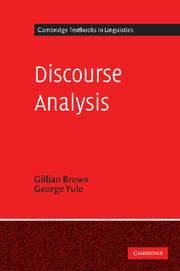Book contents
- Frontmatter
- Contents
- Preface
- Acknowledgements
- Transcription conventions
- 1 Introduction: linguistic forms and functions
- 2 The role of context in interpretation
- 3 Topic and the representation of discourse content
- 4 ‘Staging’ and the representation of discourse structure
- 5 Information structure
- 6 The nature of reference in text and in discourse
- 7 Coherence in the interpretation of discourse
- References
- Subject index
- Author index
7 - Coherence in the interpretation of discourse
Published online by Cambridge University Press: 05 June 2012
- Frontmatter
- Contents
- Preface
- Acknowledgements
- Transcription conventions
- 1 Introduction: linguistic forms and functions
- 2 The role of context in interpretation
- 3 Topic and the representation of discourse content
- 4 ‘Staging’ and the representation of discourse structure
- 5 Information structure
- 6 The nature of reference in text and in discourse
- 7 Coherence in the interpretation of discourse
- References
- Subject index
- Author index
Summary
Coherence in discourse
One of the pervasive illusions which persists in the analysis of language is that we understand the meaning of a linguistic message solely on the basis of the words and structure of the sentence(s) used to convey that message. We certainly rely on the syntactic structure and lexical items used in a linguistic message to arrive at an interpretation, but it is a mistake to think that we operate only with this literal input to our understanding. We can recognise, for example, when a writer has produced a perfectly grammatical sentence from which we can derive a literal interpretation, but which we would not claim to have understood, simply because we need more information. Extract (1), the first sentence of a novel, may provide an illustration of this point.
(1) Within five minutes, or ten minutes, no more than that, three of the others had called her on the telephone to ask her if she had heard that something had happened out there.
(Tom Wolfe, The Right Stuff, Bantam Books, 1981)The novelist is, of course, leading his reader to read on and find out just what the first sentence, though literally complete, has only partially described.
At the opposite extreme, we can point to linguistic messages which are not presented in sentences and consequently can't be discussed in terms of syntactic well-formedness, but which are readily interpreted.
- Type
- Chapter
- Information
- Discourse Analysis , pp. 223 - 271Publisher: Cambridge University PressPrint publication year: 1983
- 1
- Cited by



